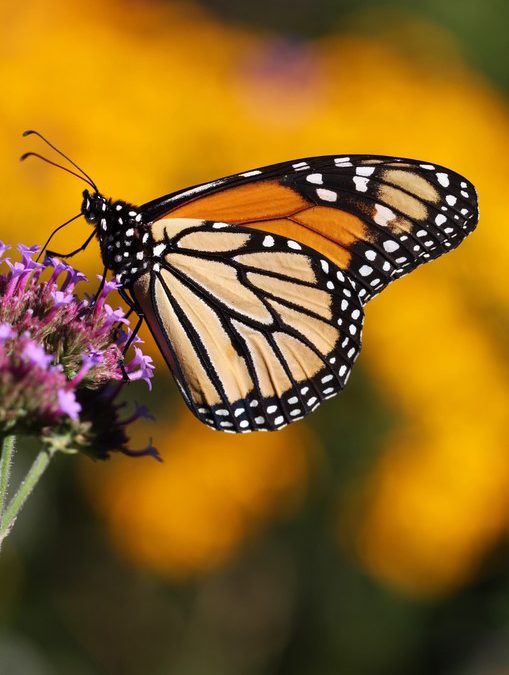
by Molly Jameson | Apr 18, 2019
With spring upon us, the mighty monarch butterflies have begun their long trek to the north from Mexico, looking to time their migration with growth of the milkweed plants in the southeastern United States. Mated monarch females lay hundreds of eggs along their journey, but only two percent of these eggs will survive to become mature caterpillars to carry on the next generation.
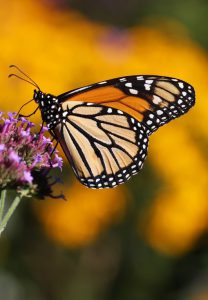
The monarch butterfly.
Photo: Steven Katovich USDA Forest Service
Monarch larvae rely exclusively on milkweed for nutrients, so it is of upmost importance that the plants are available to the offspring at the correct time. If the adult monarchs arrive too early, the milkweeds may not have had enough time to grow after late frosts. If they arrive too late, the milkweed vegetation may not support the nutrient needs of the caterpillars. In addition, the milkweeds contain a poisonous toxin, cardiac glycoside, that stays within the caterpillars’ bodies once consumed. This does not harm the larvae, but actually helps them, as it makes the young and adult butterflies taste terrible and makes them poisonous to potential predators.
For these reasons, it is important that we all do our part to support the growth of native milkweed species. Locally, the Monarch Milkweed Initiate at the St. Marks National Wildlife Refuge educates the public about milkweed and monarchs and grows and transplants native milkweed to support the monarchs on their migration.
When planting milkweed, be aware that there is a popular commercialized non-native tropical milkweed species that is not appropriate for the monarchs in our area. This species, Asclepias curassavica, can flower year-round, luring the monarchs to stay and breed in the winter when they should be on their way back to Mexico to escape freezing temperatures. Staying and breeding too long can make the monarchs susceptible to a protozoan parasite, Ophryocystis elektroscirrha (OE for short), that infects the caterpillars when feeding, reducing their lifespan, body mass, mating success rate, and ability to migrate.
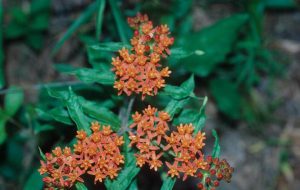
Butterfly milkweed (Asclepias tuberosa)
Photo: John Ruter, University of Georgia
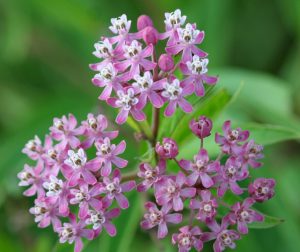
Swamp milkweed (Asclepias incarnata).
Photo: David Cappaert
Luckily, there are about 21 native milkweed species in Florida. Many native milkweeds in the Florida Panhandle require specialized care when grown for transplanting, as different species have adapted to a range of habitats. The Asclepias tuberosa, commonly referred to as butterflyweed, is considered easiest to grow as they transplant well and thrive in full sun. Others, such as Asclepias perennis, or aquatic milkweed, and Asclepias incarnata, swamp milkweed, must be grown using trays without drain holes, as their “feet” must be kept wet. The Asclepias humistrata, or sandhill milkweed, requires a drier, heavier soil.

Monarch catepillar (Danaus plexippus).
Photo: Steven Katovich, USDA Forest Service
To support the monarchs and grow milkweed in your garden, come to the Leon County Extension Office at 615 Paul Russell Road on Saturday, May 11, from 9:00 a.m. to 1:00 p.m. for the Spring Open House and Plant Sale. Master Gardeners have been busy growing native milkweeds for this event and will be on hand selling the transplants. There will also be many other Florida Friendly and native plants available, along with guided garden tours, kids’ activities, the UF/IFAS Bookstore, a silent auction, live music by the Tallahassee Woodwind Quintet, refreshments, and Master Gardeners and Extension Agents on-hand to answer any of your gardening questions.

by Scott Jackson | May 25, 2018
By L. Scott Jackson and Julie B. McConnell, UF/IFAS Extension Bay County
Northwest Florida’s pristine natural world is being threaten by a group of non-native plants and animals known collectively as invasive species. Exotic invasive species originate from other continents and have adverse impacts on our native habitats and species. Many of these problem non-natives have nothing to keep them in check since there’s nothing that eats or preys on them in their “new world”. One of the most problematic and widespread invasive plants we have in our local area is air potato vine.
Air potato vine originated in Asia and Africa. It was brought to Florida in the early 1900s. People moved this plant with them using it for food and traditional medicine. However, raw forms of air potato are toxic and consumption is not recommended. This quick growing vine reproduces from tubers or “potatoes”. The potato drops from the vine and grows into the soil to start new vines. Air potato is especially a problem in disturbed areas like utility easements, which can provide easy entry into forests. Significant tree damage can occur in areas with heavy air potato infestation because vines can entirely cover large trees. Some sources report vine growth rates up to eight inches per day!
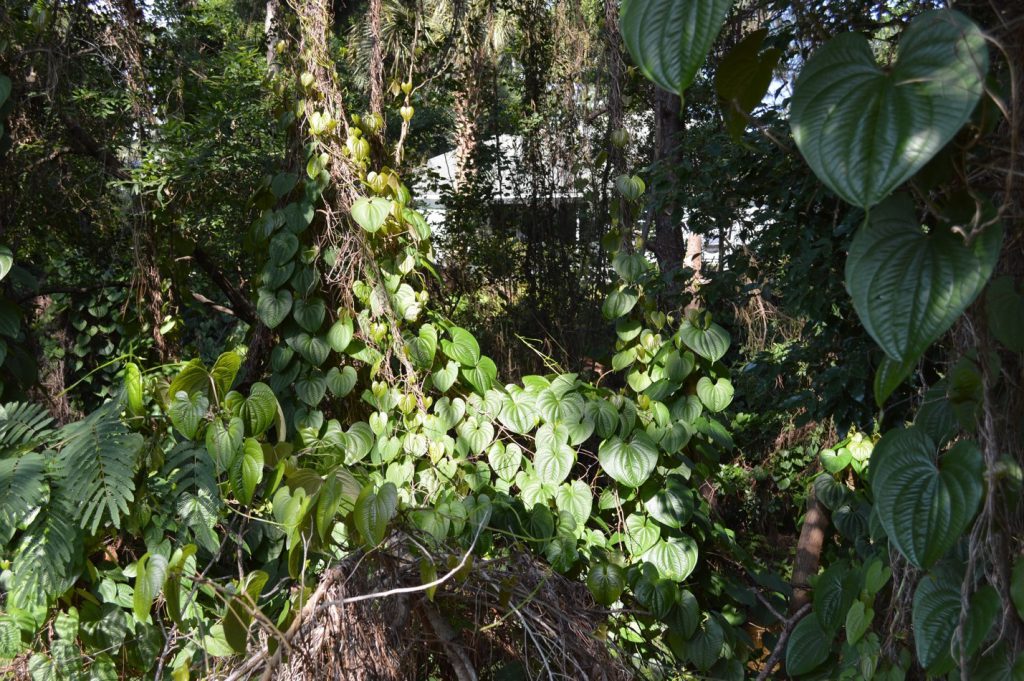
Air Potato vines covering native shrubs and trees in Bay County, Florida. (Photo by L. Scott Jackson)
Mechanical removal of vines and potatoes from the soil is one control method. Additionally, herbicides are often used to remediate areas dominated by air potato vine but this runs the risk of affecting non-target plants underneath the vine. A new tool for control was introduced to Florida in 2011, the air potato leaf beetle. Air potato beetle releases have been monitored and evaluated by United States Department of Agriculture (USDA) researchers and scientists for several years.

Air Potato Beetle crawling on leaf stem. Beetles eat leaves curtailing the growth and impact of air potato. (Photo by Julie B. McConnell)
Air potato beetles target only air potato leaves making them a perfect candidate for biological control. Biological controls aid in the management of target invasive species. Complete eradication is not expected, however suppression and reduced spread of air potato vine is realistic.
UF/IFAS Extension Bay County will host the Air Potato Challenge on June 6, 2018. Citizen scientist will receive air potato beetles and training regarding introduction of beetles into their private property infested with air potato vine. Pre-registration is recommended to receive the air potato beetles. Please visit http://bit.ly/bayairpotato
In conjunction with the Air Potato Challenge, UF/IFAS Extension Bay County will be hosting an invasive species awareness workshop. Dr. Steve Johnson, UF/IFAS Associate Professor of Wildlife Ecology, will be presenting “Exotic Invaders: Reptiles and Amphibians of Concern in Northwest Florida”. Additionally, experts from UF/IFAS Extension, Florida Fish and Wildlife, and the Science and Discovery center will have live exhibits featuring invasive reptiles, lionfish, and plants. For more information visit http://bay.ifas.ufl.edu or call the UF/IFAS Extension Bay County Office at 850-784-6105.
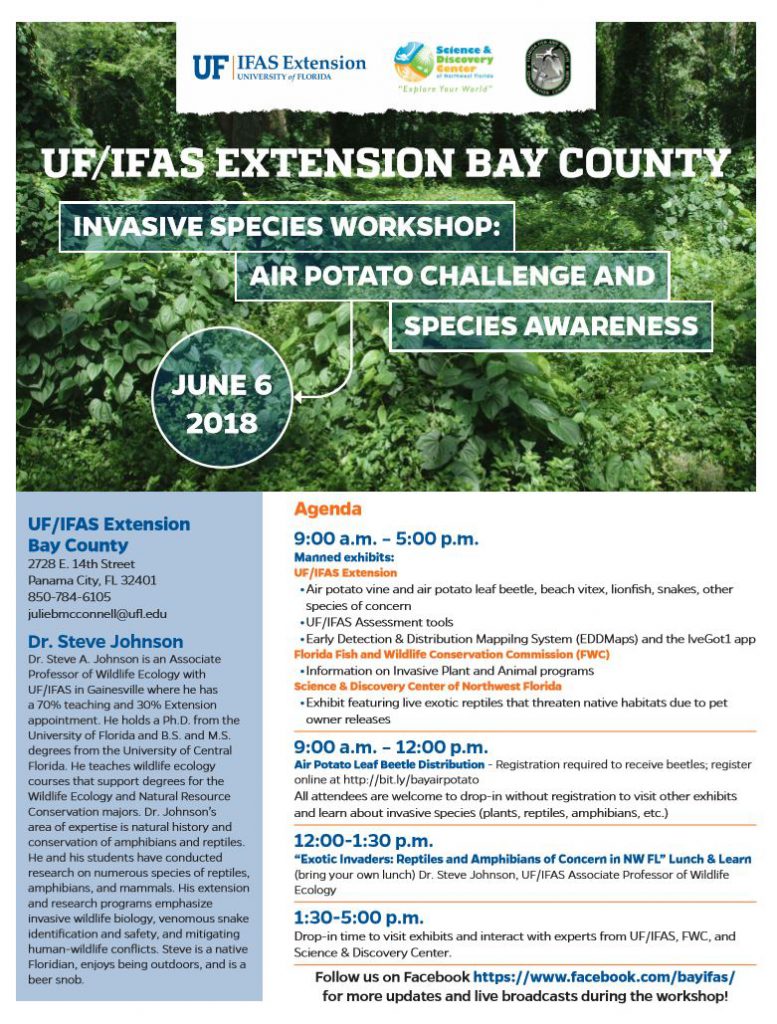
Flyer for Air Potato Challenge and Invasive Species Workshop June 6 2018

by hollyober | Mar 18, 2018

Bats sometimes move into buildings when they can’t find the natural structures they prefer (caves and large trees with cavities).
All 13 species of bats that live in Florida sleep during the day and feed on insects throughout the night. Most of these bats sleep in natural structures such as trees and caves. But when the natural structures these bats prefer are limited or vandalized, the bats may move into buildings.
Bats are a great help to us. Each of them consumes hundreds of insects per night. Bats save growers billions of dollars annually by reducing insect pests. Some of the pests bats feed on include the damaging fall armyworm, cabbage looper, corn earworm, tobacco budworm, hickory shuckworm, and pecan nut casebearer. But both bats and humans are happier when not sharing living spaces!
If you or someone you know has a group of bats living in a building where they are not welcome, you have options. The safe, humane, effective way to coax a colony of bats out of a building permanently is through a process called an ‘exclusion’. A bat exclusion is a process that prevents bats from returning to a building once they have exited at sunset to feed. This is accomplished by installing a temporary one-way door. This one-way door can take many forms, but the most common is a sheet of plastic mesh screening (with small mesh size of 0.125 x 0.125 inches or less) attached at the top and along both sides of the sheet, and open on the bottom. Another option is to install slick tubes (such as clean caulk tubes) to such entry points. These temporary one-way doors should be attached over each one of the suspected entry/exit points bats are using to get in and out of the building.
It is illegal to harm or kill bats in Florida. However, excluding bats from a building is allowed if you follow practices recommended by the Florida Fish and Wildlife Conservation Commission (FWC). According to Florida law, all bat exclusion devices must be left in place for a MINIMUM of 4 consecutive nights with temperatures above 50⁰ F before each entry point can be permanently sealed to prevent bat re-entry. Also, it is unlawful in Florida to attempt to exclude bats from a building between April 15 and August 15, which is bat maternity season. This is when female bats form large colonies and raise young that are unable to fly for their first few weeks of life. If bats were excluded during this time period, young bats (pups) would die indoors.
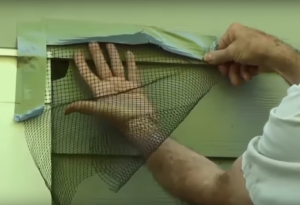
Bats can be coaxed to leave a building by first identifying the bat’s entry points into the building, and then creating a temporary one-way door using plastic screening with fine mesh size over each of these entry points.
The steps for an effective exclusion are as follows:
- Identify the locations where bats are getting in and out of the building. Look for holes or crevices about the width of your thumb, often near the roofline, with brown staining on the exterior of the building and bat scat (guano, about the size of a grain of rice and brown in color) below.
- Fashion and install one-way doors at each suspected bat entry point. This can be done anytime between August 16 and April 14 – it cannot be done when bats have young pups, which is between April 15 and August 15.
- Leave all one-way doors in place for at least 4 consecutive nights with minimum temperatures above 50⁰ F so all bats leave through the doors and cannot re-enter. If any one-way door becomes ineffective during the 4 day period, begin again. You must be absolutely certain all bats have exited so you do not block any inside the building.
- Immediately after removing the one-way doors, permanently seal each hole to prevent bats from getting back inside.
For detailed instructions on how to conduct a bat exclusion, see this video that features interviews with bat biologists from the University of Florida, FWC, and the Florida Bat Conservancy: How to Get Bats out of a Building.
For additional information on Florida’s bats, visit University of Florida’s bat advice or FWC’s bat website.
Remember, if you have a colony of bats roosting indoors that you want to exclude, you must either act within the next few weeks or else wait until the middle of August to coax them out. Bat maternity season in Florida runs from April 15 to August 15, and during this time no one can attempt to exclude bats from a building.
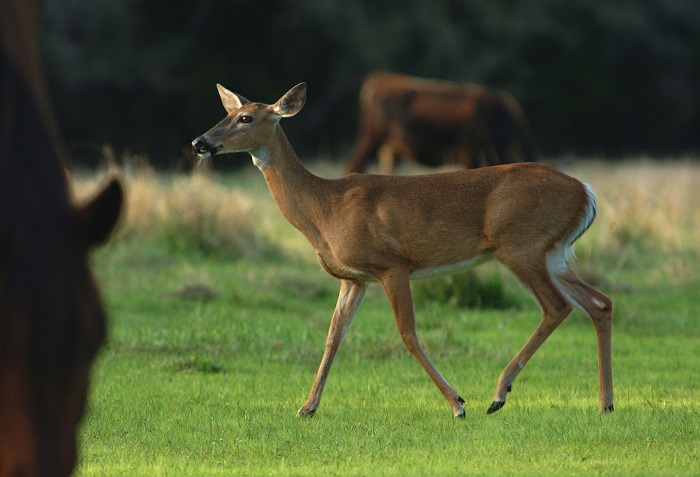
by Mark Mauldin | Aug 18, 2017

White-tailed deer, a species that is both highly sought after by sportsmen and an unwanted nuisance to many. Sportsmen modify habitat to attract deer and homeowners can modify habitat to stop attracting deer.
(Photo by Eric Zamora)
As a County Agent, I receive a wide variety of calls from clients relating to wildlife. The majority of these calls are quite positive; clients need help improving wildlife habitat or simply need a creature identified to satisfy their curiosity. However, from time to time, situations develop where wildlife behavior becomes a nuisance to a client. The following are some key concepts that can be applied to stop ongoing nuisance wildlife and/or lessen the likelihood of future nuisance wildlife causing issues around your home. For clarity, nuisance wildlife are specific animals (not an entire species) that are causing a specific problem.
Animals frequent various areas because those areas provide resources necessary to meet the animals’ needs. Animals have three basic needs: 1) Food 2) Water 3) Cover. If an animal(s) is frequenting your property and causing some kind of damage, as to become a nuisance, it is incredibly likely that the animal’s presence and nuisance behavior are related to the animal seeking food, water, or cover. With this concept in mind, there is a four-step process that can be utilized to alleviate the issue.
Step 1: Identify the species of animal responsible for the nuisance behavior. Accurate identification of the species causing the problem is key to developing a successful plan of action for stopping the issue. Do not make assumptions or guesses, use available resources to make a definitive identification. Animals can generally be identified by looking at the type of damage caused (i.e. soil disturbance, tree bark damage, vegetation clipping, garden damage, etc.), signs left by the animal (scat, tracks, etc.), and the time of day/night the damage occurs. Careful observation of these factors should lead to an accurate identification of the nuisance animal.
Step 2: Determine why the animal is frequenting your property. After you have identified the problem animal and familiarized yourself with its normal behaviors you should be able to deduce what the animal finds appealing about your property. In some cases, the damage caused by the animals plainly shows why they are there, other times it might not be as obvious. Remember, they are likely there in search of food, water, or cover.
Step 3: Implement steps to address the situation. After you have determined “what & why” you can formulate an appropriate plan for addressing the issue. Generally, the plan will include steps in one or more of the following categories:
1) Habitat modification – This is generally the most practical approach to dealing with nuisance wildlife. In its simplest form, habitat modification is simply removing or altering whatever environmental factor is attracting the nuisance wildlife. The most common example of habitat modification is the removal of wildlife food sources (i.e. pet food, bird feeders, easily accessible garbage and/or compost).
2) Deterrents – Any measure that restricts access to the resource desired by the nuisance wildlife. These measures can include, physical barriers (fencing, etc.), hazing or scare tactics (eyespot balloons, holographic foil, motion-sensitive sprinklers, noise-makers, dogs), and chemical repellents. Deterrents are generally more expensive than habitat modification and their effectiveness tends to decrease over time.
3) Trapping or killing the nuisance animal – These are only to be considered as last resorts. Even when trapping or killing is the only option, they generally only provide a temporary solution to the problem if the environmental factor drawing the animals is not also addressed. Additionally, many state and federal regulations that dictate when trapping or killing wildlife is permissible.
Step 4: Evaluate your level of success and make necessary adjustments. Observe any changes in wildlife behavior and modify your approach as necessary. Begin with habitat modification; if that is not effective make sure the correct modification(s) was made. If no additional modification can be made look at deterrents. Only if all habitat modification and deterrent options have proven ineffective would you move on to trapping or killing. As you move through this process you may wish to seek professional assistance. Contact your county’s UF/IFAS Extension Office for general advice or FWC for a list of professional nuisance wildlife trappers.
This article was adapted from Overview of How to Stop Damage Caused by Nuisance Wildlife in Your Yard by Holly K. Ober and Arlo Kane. There are links throughout the article to a series of publications by the same authors that explore the various topics in detail.
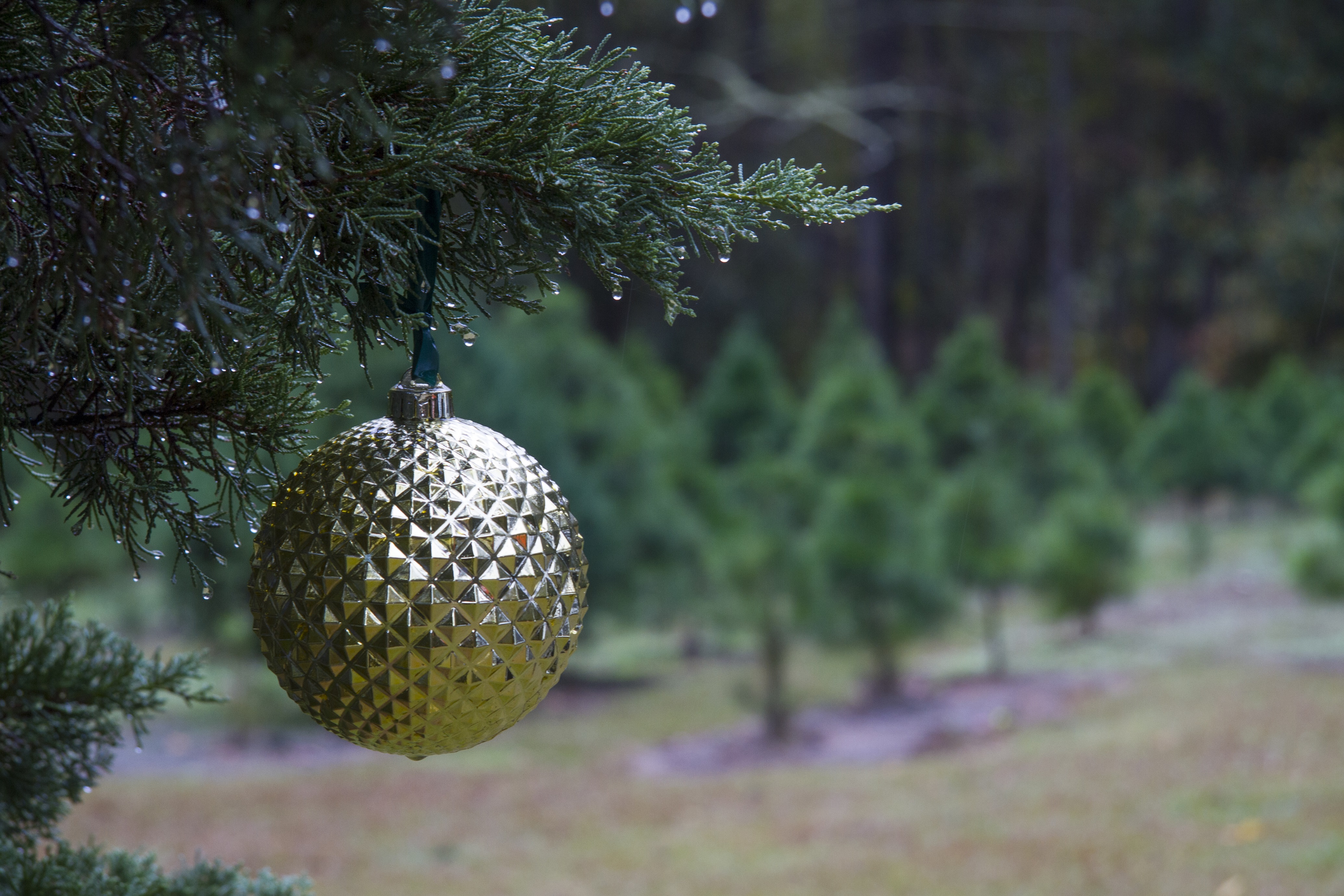
by hollyober | Dec 16, 2016

Christmas trees can provide benefits to wildlife long after they have served as holiday decoration indoors. Credits: IFAS photo database.
Americans purchased approximately 30 million live Christmas trees last year. If you plan to have a live tree this winter, and you’re wondering what you could do with your tree once it has finished its role as holiday decoration in your home, read below. Rather than simply dragging your tree to the curb for the waste disposal truck to pick up, you could prolong the life of your holiday tree by repurposing it to benefit wildlife.
YOUR TREE COULD PROVIDE FOOD FOR WILDLIFE
Many of the needles may have dropped from your Christmas tree as it dried out while indoors, but the branches should still be intact. This means your tree could be used as a frame to present food for wildlife. After removing your indoor decorations, consider propping the tree up in your yard (perhaps using the same stand you used indoors), and adorning the branches with food enjoyed by wildlife visitors. Some low-budget options include mesh bags filled with bird seed (black oil sunflower seed, safflower seed, and thistle (nyjer) are favorites of many common backyard birds), pine cones smeared with peanut butter, home-made suet cakes, and strings of fruit such as apple slices, orange slices, or grapes. If you choose this option, beware that you may attract not only birds, but mammals such as squirrels, raccoons, opossums, and others.
If you’d like to watch your wildlife visitors, be sure to attach the food items with string so that the animals must eat the food at the site of the tree rather than carrying it away to eat or store elsewhere out of view. Consider using a biodegradable string (i.e., cotton) to secure the food items to your tree so you can eventually compost the tree without worrying about needing to remove the string.
YOUR TREE COULD PROVIDE SHELTER FOR WILDLIFE
If you’re tired of seeing your holiday tree in its upright position, consider taking it outdoors, laying it down, and heaping other vegetative debris loosely on top to form a ‘brush pile’. Brush piles are mounds of woody vegetation created specifically to provide shelter for wildlife.
The lower portions of a brush pile can offer cool, shaded conditions that allow small mammals such as rabbits to hide from the weather and from predators. Meanwhile, the upper portions can serve as perch sites for songbirds. The entire pile may be used as resting sites for amphibians and reptiles. In yards with few understory trees or shrubs, and at times of year when many trees and shrubs have limited foliage, these brush piles can provide much-appreciated cover for many kinds of wildlife.
YOUR TREE COULD PROVIDE SHELTER FOR FISH
Your retired Christmas tree could be used to make long-lasting habitat improvements for fish. In artificial ponds with little submerged vegetation, the addition of one or more Christmas trees could upgrade the quality of refuge and feeding areas for fish. Small fishes may hide among purposely submerged Christmas trees for protection, and larger fishes may follow them. If you’ve got an artificial pond on your property, consider adding discarded trees to create a place where fish can hide and find food, and also to concentrate fish for angling. Simply secure a cinder block to your holiday tree using heavy wire or thin cable and place it far enough from shore that water covers the top of the tree by a couple of feet. When constantly submerged, Christmas trees can persist for many years underwater.
Not only can your tree offer enjoyment to you when decorated with lights and ornaments indoors, but it can also allow you to provide post-holiday gifts to the wildlife and fish on your property.
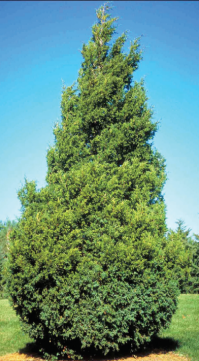
by Sheila Dunning | Dec 5, 2016
 Throughout history the evergreen tree has been a symbol of life. “Not only green when summer’s here, but also when
Throughout history the evergreen tree has been a symbol of life. “Not only green when summer’s here, but also when 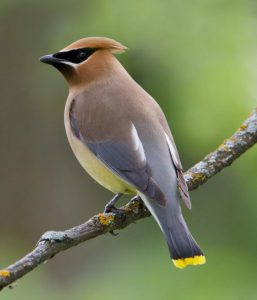 it’s cold and dreary” as the Christmas carol “O Tannenbaum” says. While supporting the cut Christmas tree industry does create jobs and puts money into local economics, every few years consider adding to the urban forest by purchasing a living tree. Native evergreen trees such as Redcedar make a nice Christmas tree that can be planted following the holidays. The dense growth and attractive foliage make Redcedar a favorite for windbreaks, screens and wildlife cover. The heavy berry production provides a favorite food source for migrating Cedar Waxwing birds. Its high
it’s cold and dreary” as the Christmas carol “O Tannenbaum” says. While supporting the cut Christmas tree industry does create jobs and puts money into local economics, every few years consider adding to the urban forest by purchasing a living tree. Native evergreen trees such as Redcedar make a nice Christmas tree that can be planted following the holidays. The dense growth and attractive foliage make Redcedar a favorite for windbreaks, screens and wildlife cover. The heavy berry production provides a favorite food source for migrating Cedar Waxwing birds. Its high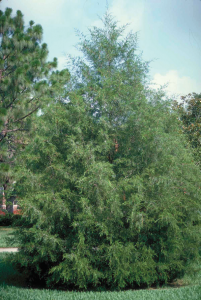 salt-tolerance makes it ideal for coastal locations. Their natural pyramidal-shape creates the traditional Christmas tree form, but can be easily pruned as a street tree. Two species, Juniperus virginiana and Juniperus silicicola are native to Northwest Florida. Many botanists do not separate the two, but as they mature, Juniperus silicicola takes on a softer, more informal look. When planning for using a live Christmas tree there are a few things to consider. The tree needs sunlight, so restrict its inside time to less than a week. Make sure there is a catch basin for water under the tree, but never allow water to remain in the tray and don’t add fertilizer. Locate your tree in the coolest part of the room and away from heating ducts and fireplaces. After Christmas, install the Redcedar in an open, sunny part of the yard. After a few years you will be able to admire the living fence with all the wonderful memories of many years of holiday celebrations. Don’t forget to watch for the Cedar Waxwings.
salt-tolerance makes it ideal for coastal locations. Their natural pyramidal-shape creates the traditional Christmas tree form, but can be easily pruned as a street tree. Two species, Juniperus virginiana and Juniperus silicicola are native to Northwest Florida. Many botanists do not separate the two, but as they mature, Juniperus silicicola takes on a softer, more informal look. When planning for using a live Christmas tree there are a few things to consider. The tree needs sunlight, so restrict its inside time to less than a week. Make sure there is a catch basin for water under the tree, but never allow water to remain in the tray and don’t add fertilizer. Locate your tree in the coolest part of the room and away from heating ducts and fireplaces. After Christmas, install the Redcedar in an open, sunny part of the yard. After a few years you will be able to admire the living fence with all the wonderful memories of many years of holiday celebrations. Don’t forget to watch for the Cedar Waxwings.



















